Page 222 of 308
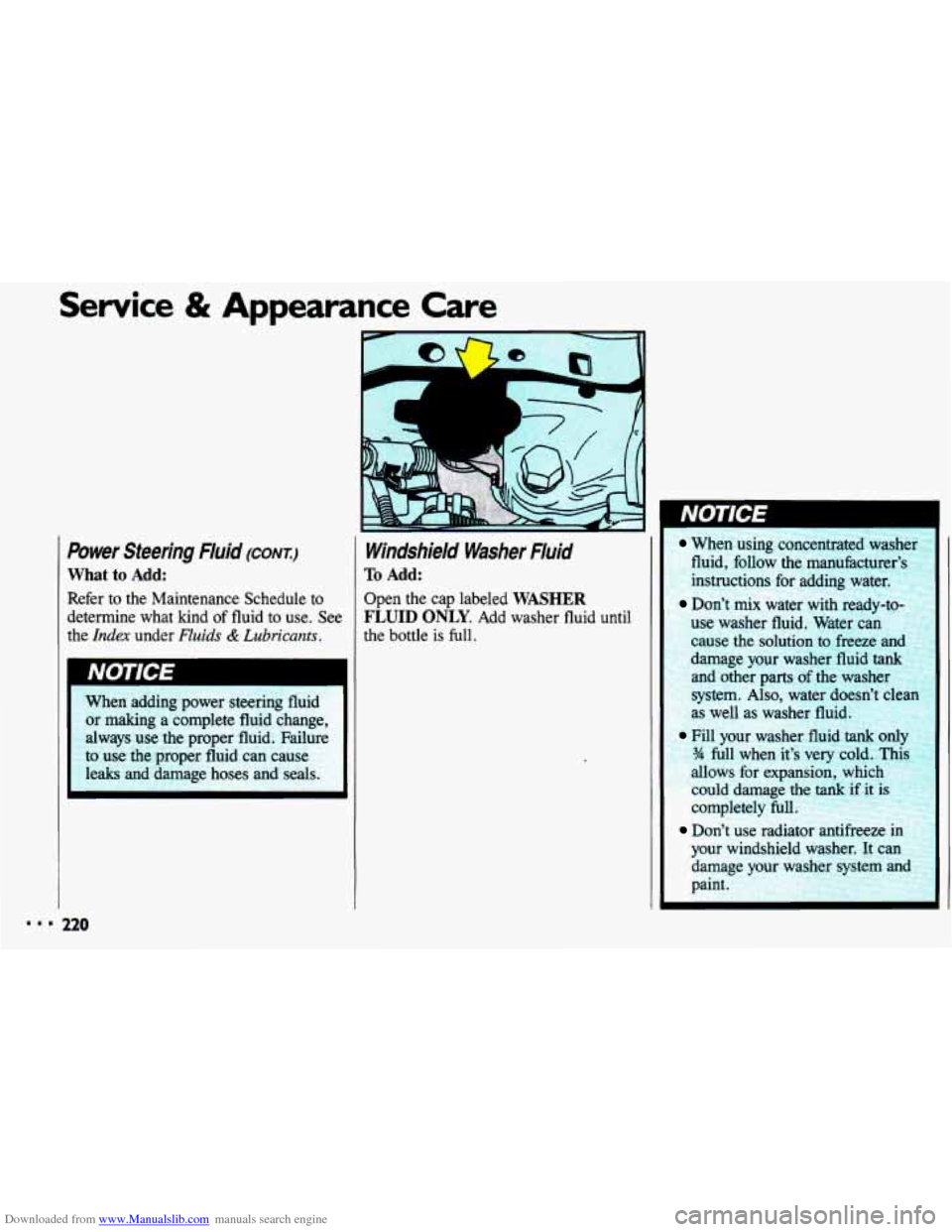
Downloaded from www.Manualslib.com manuals search engine ..I
Service & Appearance Care
Power Steering Fluid (CONT.)
What to Add:
Refer to the Maintenance Schedule to determine what kind of fluid to use. See
the
Index under Fluids & Lubricants.
When adding power steering fluid
or making a complete fluid change,
always use the proper fluid. Failure
to use the proper fluid can cause
leaks and damage hoses and seals.
120
Windshield Washer Fluid
To Add:
Open the cap labeled WASHER
FLUID ONLY. Add washer fluid until
the bottle is full.
When using concentrated washer
fluid, follow the manufacturer’s
instructions for adding water.
Don’t mix water with ready-to-
l15e washer fluid. Water can
use the solution
to freeze and
. .tmage your washer fluid tank
and other parts of the washer
system.
Also, water doesn’t clean
s well as washer fluid.
Fill your washer fluid tank on14
?4 full when it’s very cold. Thir
allows for expansion, which
could damage the
tank if it is
completely
full
Don’t use radiator antifreeze
your windshield washer.
It can
damage your washer system an(
paint.
Page 224 of 308
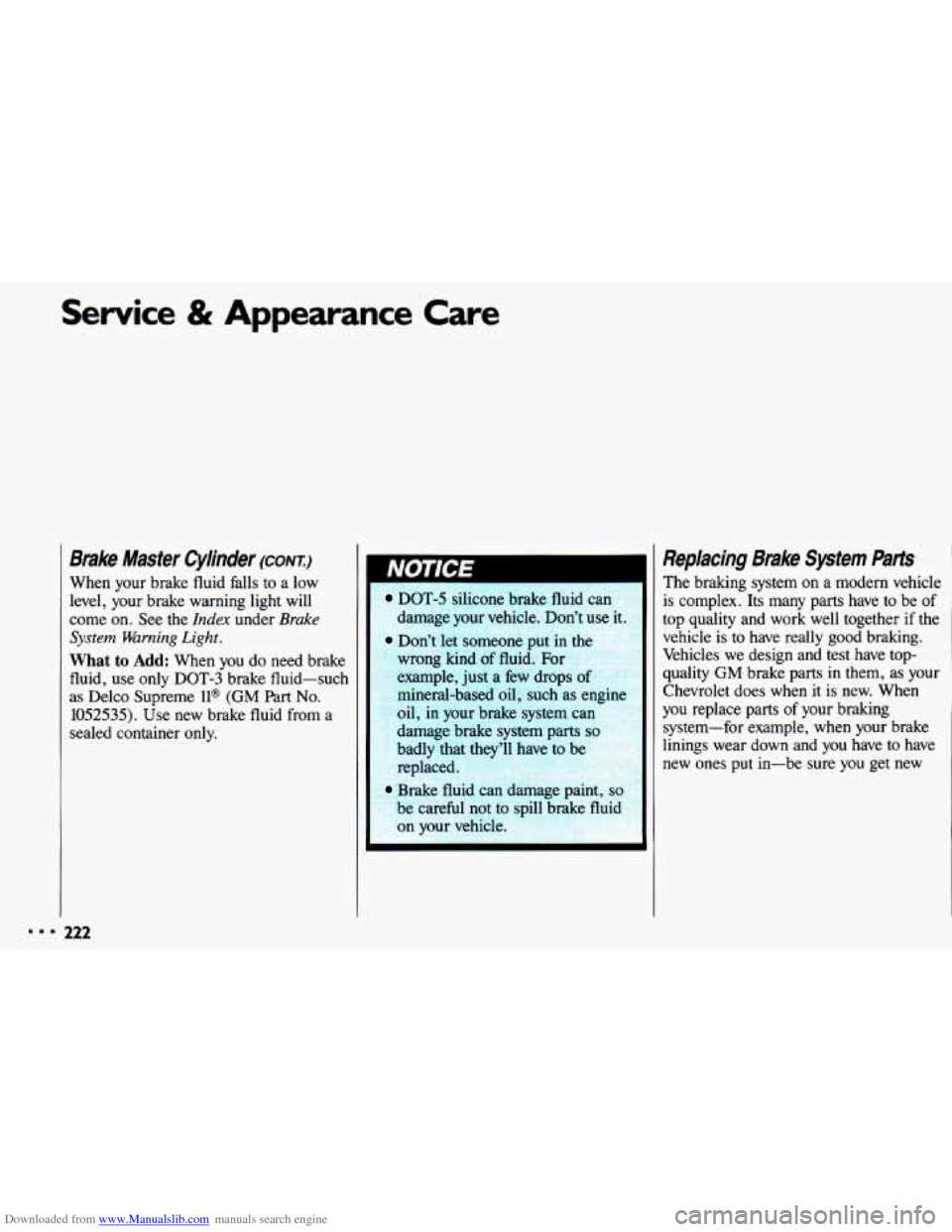
Downloaded from www.Manualslib.com manuals search engine Service & Appearance Care
I’ A
Brake Master Cylinder (CONT.)
When your brake fluid falls to a low
level, your brake warning light will
come
on. See the Index under Brake
System Warning Light.
What to Add: When you do need brake
fluid, use only DOT-3 brake fluid-such
as Delco Supreme
ll@ (GM Part No.
1052535). Use new brake fluid from a
sealed container only.
122
DOT-5 silicone brake fluid can
damage your vehicle. Don’t use it.
Don’t let someone put in the
wrong kind
of fluid. For
example, just a few drops
of
mineral-based oil, such as engine
oil, in your brake system can
damage brake system parts
so
badly that they’ll have to be
replaced.
Brake fluid can damage ‘.nt, so
be careful not to spill brae fluid
on your vehicle.
Replacing Brake System parfs
The braking system on a modern vehicle
is complex.
Its many parts have to be of
top quality and work well together
if the
vehicle
is to have really good braking.
Vehicles we design and test have top-
quality
GM brake parts in them, as your
Chevrolet does when it
is new. When
you replace parts of your braking
system-for example, when your brake
linings wear down and
you have to have
new ones put in-be sure you get new
Page 226 of 308
Downloaded from www.Manualslib.com manuals search engine Service & Appearance Care
1 Halogen Bulbs Headlight Bulb Replacement
~1 For the type of bulb, see the Index under
Replacement Bulbs.
Halogen bulbs have
bLl3t if you drop or scratch the
bulb.
You or others could be
injured. Take special care when
handling and disposing
of halogen
bulbs.
L: pressurized gas inside and can
3
1. Turn the lock ring clockwise until the
flanges align with the slots in the
housing. Then pull the ring back
from the housing.
from the housing.
224
Page 228 of 308
Downloaded from www.Manualslib.com manuals search engine DDD
Service & Appearance Care
Tai//ight Bulb Replacement
(CONr)
3. Press the bulb housing release lever
and turn the housing turn
counterclockwise to remove it.
4. To remove the bulb, push in and
rotate
it counterclockwise.
5. Reverse all steps to reassemble the
taillight housing.
226
Wagon:
1. Open the liftgate.
2. Remove the two Torx@ screws.
3. Pull back gently on the taillight
housing.
4. Press the bulb housing tab, rotate the housing counterclockwise
f/6 turn and
remove it.
Page 230 of 308
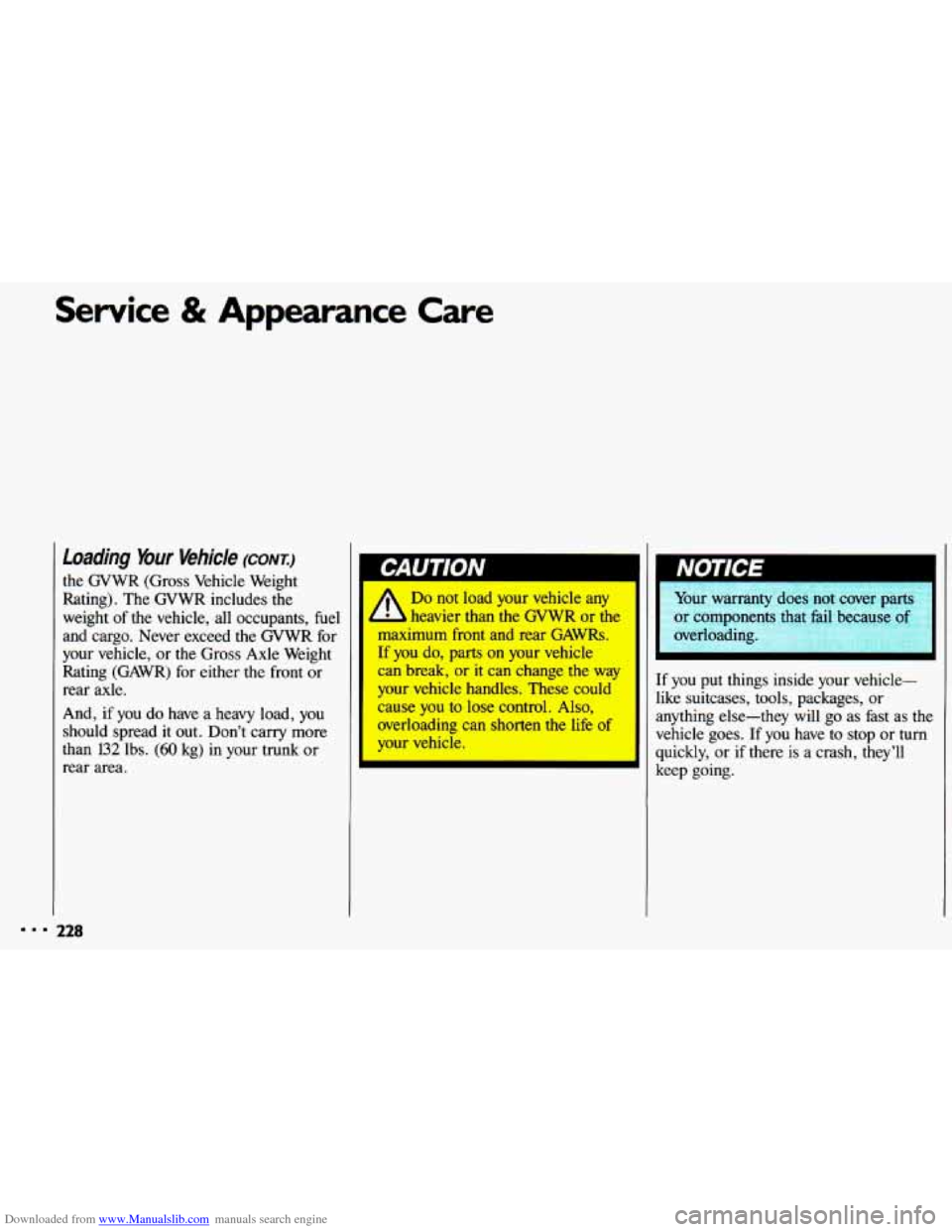
Downloaded from www.Manualslib.com manuals search engine Service & Appearance Care
Loading Your Vehicle (CONI:)
the GVWR (Gross Vehicle Weight
Rating). The GVWR includes the
weight of the vehicle, all occupants, fuel
and cargo. Never exceed the GVWR for
your vehicle, or the Gross Axle Weight
Rating (GAWR) for either the front or
rear axle.
And,
if you do have a heavy load, you
should spread
it out. Don’t carry more
than
132 lbs. (60 kg) in your trunk or
rear area.
128
Do not load your vehicle any
L b heavier than the GVWR or the
maximum front and rear GAWRs.
If
you do, parts on your vehicle
can break, or
it can change the way
your vehicle handles. These could
cause you to lose control. Also,
overloading can shorten the life of
your vehicle. Your
warranty does not cover part
or components that fail beca
: ol
overloading.
If you put things inside your vehicle-
like suitcases, tools, packages, or
anything else-they
will go as fast as the
vehicle goes. If you have to stop or turn
quickly, or
if there is a crash, they’ll
keep going.
Page 232 of 308
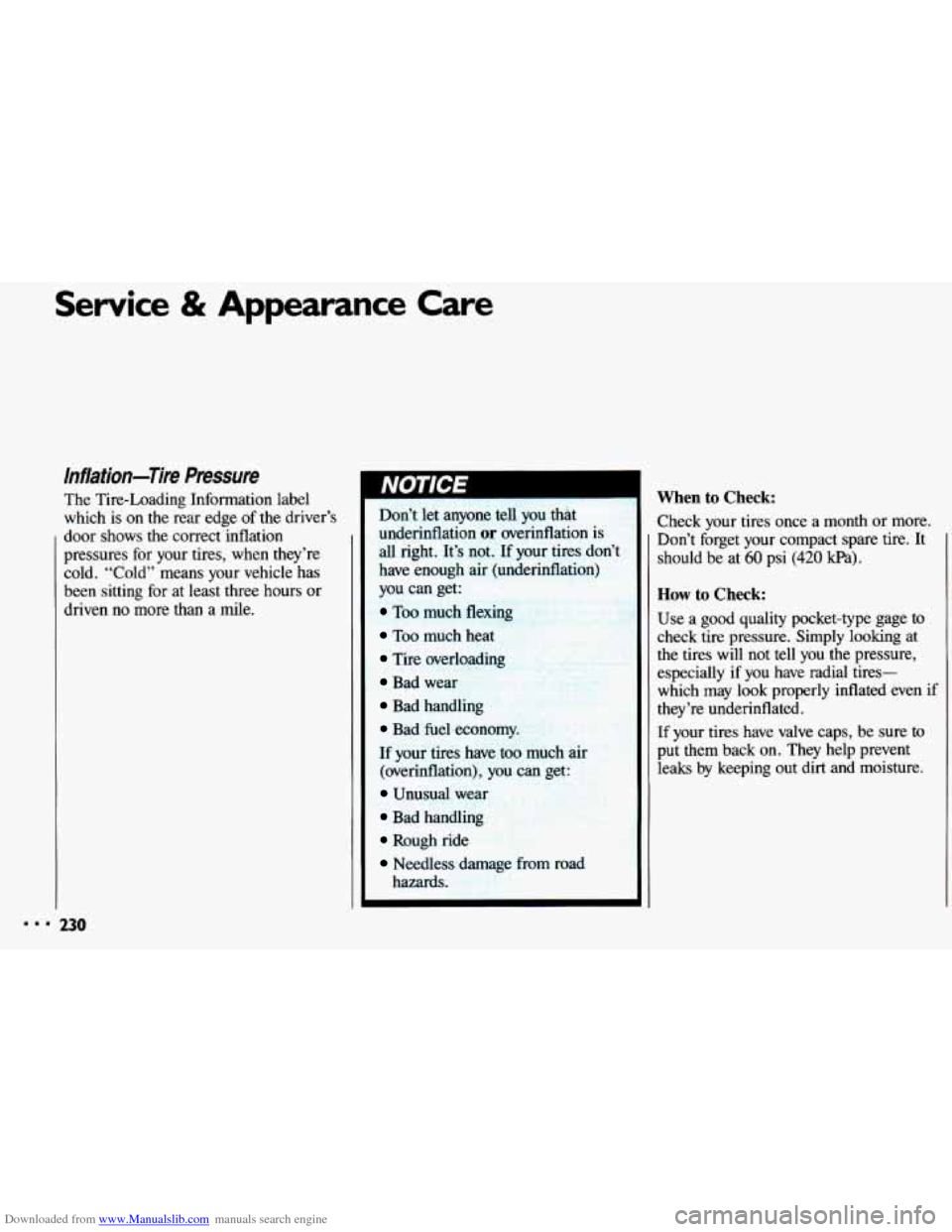
Downloaded from www.Manualslib.com manuals search engine Service & Appearance Care
lnflation-lire Pressure
The Tire-Loading Information label
which is
on the rear edge of the driver’s
door shows the correct inflation
pressures for your tires, when they’re
cold. “Cold” means your vehicle has
been sitting for at least three hours or
driven no more than a mile. Don’t
let anyone tell you that
underinflation
or overinflation is
all right. It’s
not. If your tires don’t
have enough
you can get:
Too much flexing
Too much heat
Tire overloading
Bad weLA
Bad handling
Bad fuel economy. ition)
If your tires have too much air
(overinflation), you can get:
Unusual wear
Bad handling
Rough ride
Needless damage from road
hazards.
When to Check:
Check your tires once a month or more.
Don’t forget your compact spare tire. It
should be at
60 psi (420 kpa).
How to Check:
Use a good quality pocket-type gage to
check tire pressure. Simply looking at
the tires will not tell you the pressure,
especially if
you have radial tires-
which may look properly inflated even if
they’re underinflated.
If your tires have valve caps, be sure to
put them back on. They help prevent
leaks by keeping out dirt and moisture.
230
Page 233 of 308
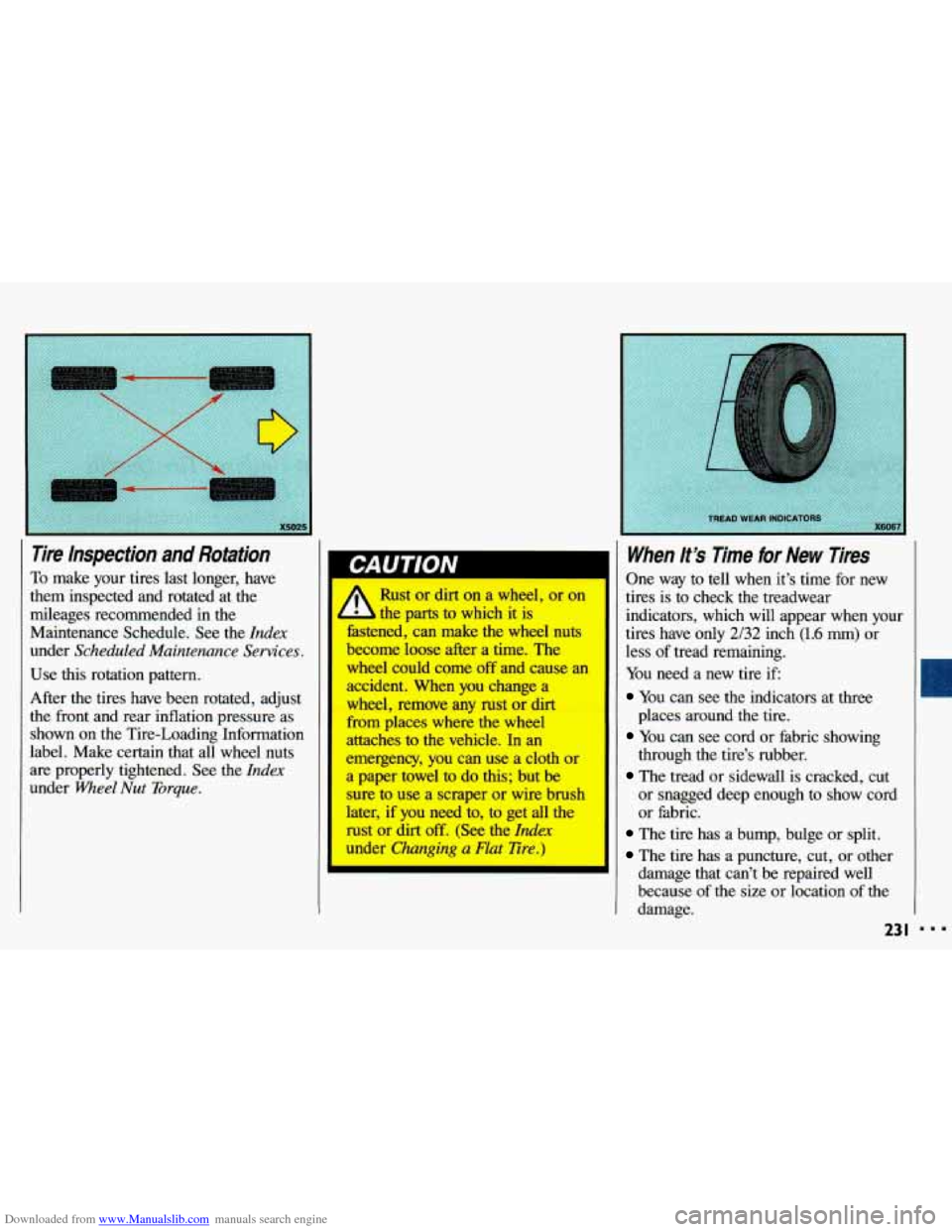
Downloaded from www.Manualslib.com manuals search engine Tire hspection and Rotation I
Use this rotation pattern.
After the tires have been rotated, adjust
the front and rear inflation pressure as
shown on the Tire-Loading Information
label. Make certain that all wheel nuts
are properly tightened. See the Index
under Wheel Nut Torque.
To make your tires last longer, have
them inspected and rotated at the
mileages recommended in the
Maintenance Schedule. See the
Index
under Scheduled Maintenance Services.
u I I’ -
Rust or dirt on a wheel, or on
; parts to which it is
fastened, can make the wheel nuts
become loose after a time. The
wheel could come off and cause an
accident. When you change a
wheel, remove any rust or dirt
from
places where the wheel
attaches to the vehicle. In an
emergency, you can use a cloth or
a paper towel to do this; but be
sure to use a scraper or wire brush
later, if you need to, to get all the
rust or dirt
off. (See the Index
under Changing a Flat Tire.)
When lt’s Time for New Tires
One way to tell when it’s time for new
tires
is to check the treadwear
indicators, which will appear when your
tires have
only 2/32 inch (1.6 mm) or
less of tread remaining.
You need a new tire if
You can see the indicators at three
You can see cord or fabric showing
The tread or sidewall is cracked, cut
places around the tire.
through the tire’s rubber.
or
snagged deep enough to show cord
or fabric.
The tire has a bump, bulge or split.
The tire has a puncture, cut, or other
damage that can’t be repaired well
because
of the size or location of the
damage.
23 I
Page 234 of 308
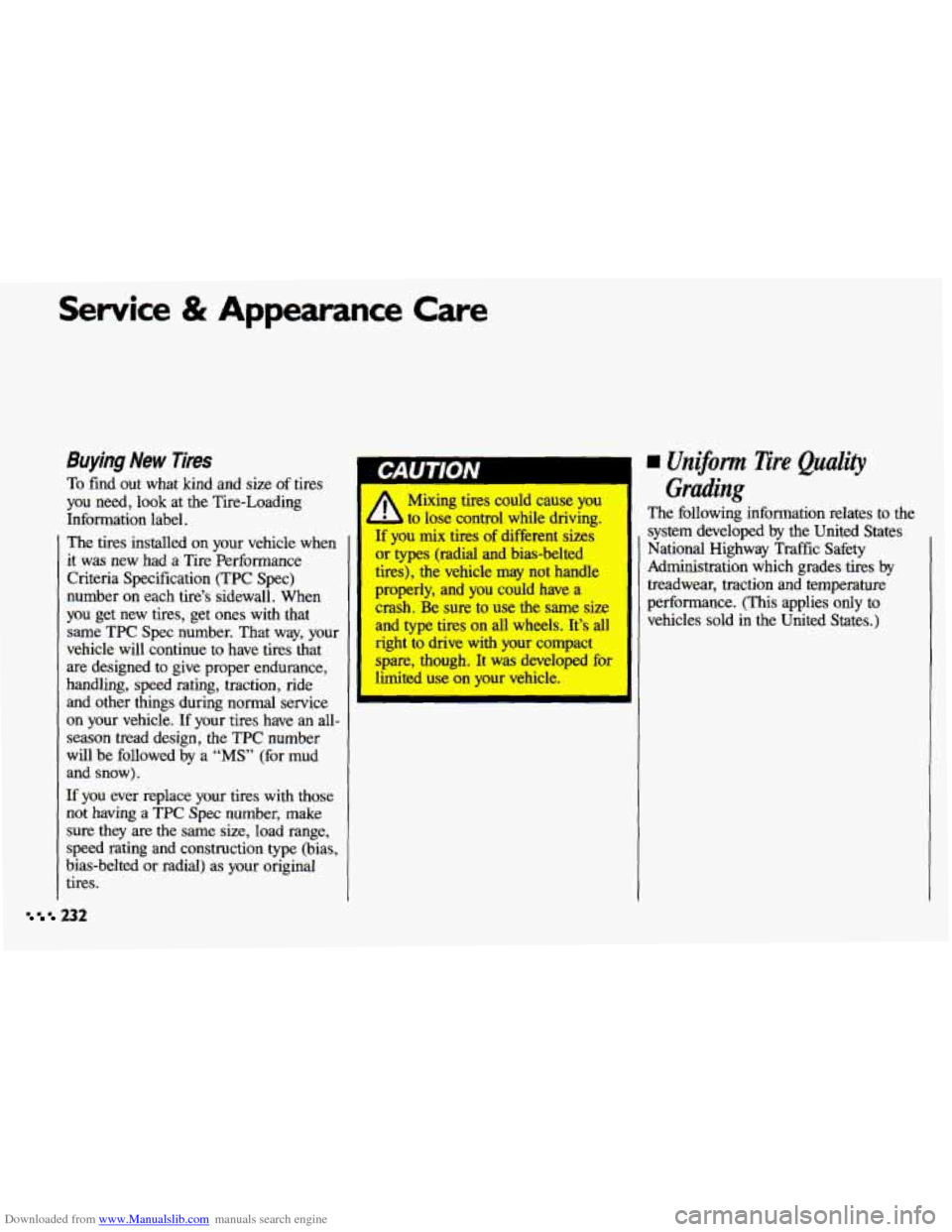
Downloaded from www.Manualslib.com manuals search engine Service & Appearance Care
Buying New Tires
To find out what kind and size of tires
you need, look at the Tire-Loading
Information label.
The tires installed on your vehicle when
it was new had a Tire Performance
Criteria Specification (TPC Spec)
number on each tire’s sidewall. When
you get new tires, get ones with that
same
TPC Spec number. That way, your
vehicle will continue to have tires that are designed to give proper endurance,
handling, speed rating, traction, ride
and other things during normal service
on your vehicle. If your tires have an all- season tread design, the TPC number
will be followed by a
“MS” (for mud
and snow).
If you ever replace your tires with those
not having a TPC Spec number, make
sure they are the same size, load range,
speed rating and construction type (bias,
bias-belted or radial) as your original
tires.
Mixing tires could cau’se you
d to lose control while driving.
If you mix tires of different sizes
or types (radial and bias-belted
tires), the vehicle
may not handle
properly,
and you could have a
crash. Be sure to use the same size
and type tires on all wheels. It’s all
right to drive with your compact
spare, though. It was developed for
limited use on your vehicle.
I I
Unijiorpn Tire Quality
Grading
The following information relates to the
system developed by the United States
National Highway Traffic Safety
Administration which grades tires by
treadwear, traction and temperature
performance. (This applies only to vehicles sold in the United States.)
232